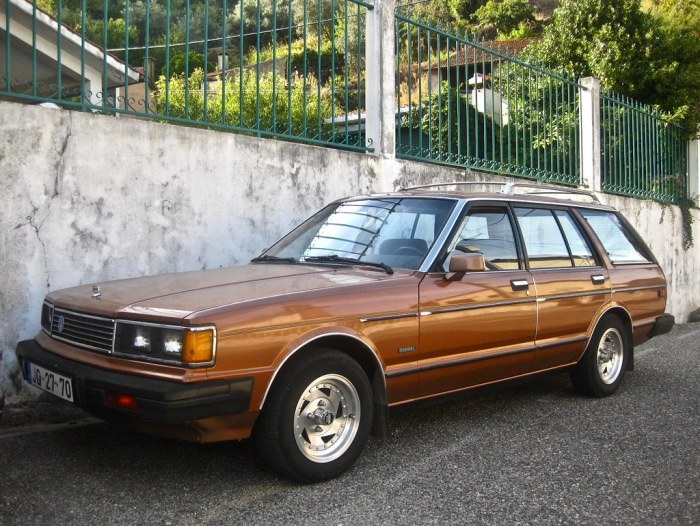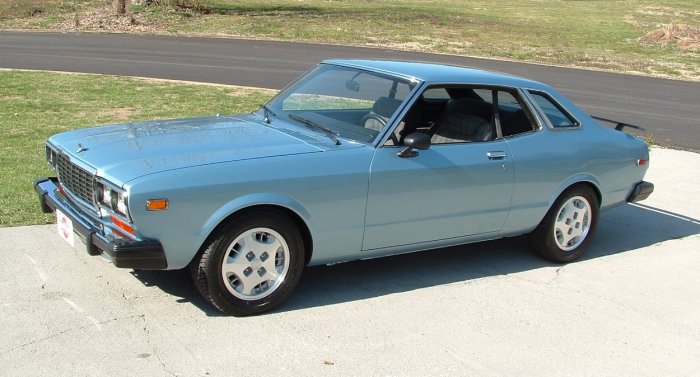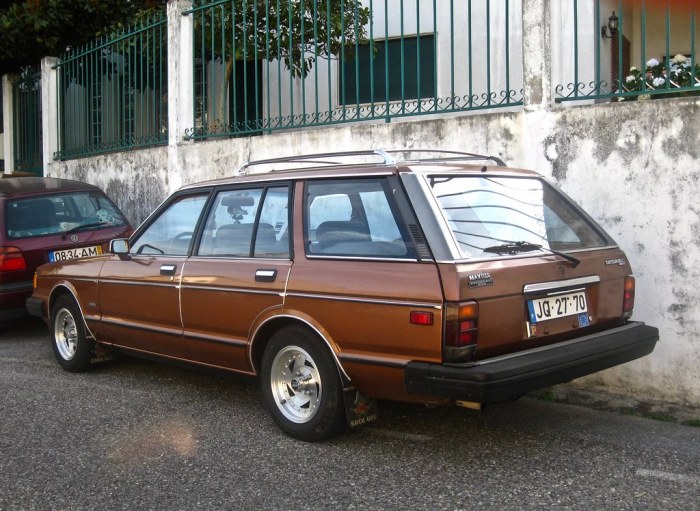The 1980 Datsun 810, a name that evokes memories of a bygone era, was a Japanese sedan that carved its own path in the automotive landscape. This was a time when Japanese cars were gaining recognition for their reliability and fuel efficiency, and the 810 was a prime example of this shift.
With its sharp styling, spacious interior, and potent engine options, the 810 was a compelling choice for those seeking a balance of performance and practicality.
From its origins as a successor to the popular 610 model, the 810 represented Datsun’s ambition to compete in the upper echelons of the sedan market. It offered a blend of comfort, performance, and refinement that appealed to a wide range of drivers.
The 1980 model year brought subtle refinements, further enhancing the 810’s appeal and solidifying its place in automotive history.
History and Background: 1980 Datsun 810

The Datsun 810, a mid-size car produced by Nissan Motors, holds a significant place in automotive history, representing a pivotal moment in the Japanese automaker’s global expansion. It was a departure from Datsun’s previous focus on smaller, more economical vehicles, aiming to compete directly with established European and American competitors in the burgeoning mid-size market.The 810’s genesis can be traced back to the early 1970s, when Datsun sought to broaden its appeal beyond its traditional value-oriented customer base.
The company recognized the growing demand for larger, more luxurious cars, particularly in the United States, where it was experiencing rapid sales growth. This ambition led to the development of the 810, a car designed to offer a blend of performance, comfort, and refinement, qualities typically associated with European and American marques.
The Datsun 810’s Place in the Model Lineup
The Datsun 810 was introduced in 1976 as a successor to the Datsun 610, effectively establishing itself as the flagship model in the Datsun lineup. It was positioned as a more premium offering, featuring a larger, more powerful engine and a more sophisticated interior.
The 810’s arrival marked a significant shift in Datsun’s strategy, signaling its ambition to challenge established players in the mid-size segment.
The 1980 Model Year
The 1980 model year saw several notable changes and updates to the Datsun 810, reflecting Nissan’s continuous efforts to refine and improve the car. These updates included:
- Engine Enhancements:The 810 continued to be powered by the L24, a 2.4-liter inline-six engine, but for 1980, it received a revised intake manifold and other refinements, boosting horsepower and torque. This improved engine performance provided a more satisfying driving experience.
- Interior Refinements:The 1980 810 featured a redesigned interior, with a more modern dashboard layout and higher-quality materials. This focus on interior quality further enhanced the car’s appeal as a premium offering.
- Increased Fuel Efficiency:Recognizing the growing importance of fuel economy in the wake of the energy crisis, Nissan implemented several measures to improve the 810’s fuel efficiency. These included the adoption of a more aerodynamic body design and the introduction of a new four-speed automatic transmission.
These changes and updates for the 1980 model year further solidified the Datsun 810’s position as a compelling and competitive option in the mid-size segment. The car’s combination of performance, comfort, and fuel efficiency made it a strong contender against established rivals like the Ford Granada, Chevrolet Malibu, and Toyota Cressida.
Design and Features

The 1980 Datsun 810, despite its modest origins, offered a surprisingly refined and sophisticated design, reflecting a shift towards a more upscale and comfortable driving experience. This was a departure from the more utilitarian approach of earlier Datsun models, marking a significant step forward in the brand’s evolution.
Exterior Design
The 810’s exterior design was a blend of sharp angles and flowing curves, giving it a distinctive and somewhat sporty appearance. The front end featured a prominent grille with a horizontal chrome bar, flanked by rectangular headlights. The side profile was characterized by a long hood, a gently sloping roofline, and a pronounced rear window.
The rear end was relatively simple, with a wide, horizontal taillight design.
The 1980 Datsun 810 was a significant departure from its predecessors, offering a more refined and luxurious experience. While it may not have the same sporty heritage as the 1969 Datsun 2000 , it was a testament to Datsun’s commitment to building cars that appealed to a wider audience.
The 810’s focus on comfort and practicality made it a popular choice for families and commuters, establishing it as a key player in the mid-size sedan market.
Interior Design
The interior of the 1980 Datsun 810 was equally well-appointed, with a focus on comfort and functionality. The dashboard featured a simple, driver-oriented layout with easy-to-read gauges. The seats were comfortable and supportive, with ample legroom and headroom for both front and rear passengers.
The 810 also offered a variety of convenience features, including air conditioning, power steering, and an AM/FM radio.
Engine Options, Transmissions, and Drivetrain
The 1980 Datsun 810 was available with a choice of two engines: a 2.0-liter four-cylinder engine producing 91 horsepower, and a more powerful 2.4-liter four-cylinder engine generating 115 horsepower. Both engines were paired with a four-speed manual transmission or a three-speed automatic transmission.
The 810 was available in both rear-wheel drive and front-wheel drive configurations, depending on the trim level.
Trim Levels and Equipment
The 1980 Datsun 810 was offered in several trim levels, each with its own unique set of standard and optional features. The following table provides a summary of the different trim levels and their key features:
| Trim Level | Standard Equipment | Optional Equipment |
|---|---|---|
| 810 | 2.0-liter four-cylinder engine, four-speed manual transmission, rear-wheel drive, vinyl upholstery, AM/FM radio | Power steering, air conditioning, automatic transmission, power brakes, alloy wheels |
| 810 Deluxe | 2.4-liter four-cylinder engine, four-speed manual transmission, rear-wheel drive, cloth upholstery, AM/FM radio, power steering, air conditioning | Automatic transmission, power brakes, alloy wheels |
| 810 Maxima | 2.4-liter four-cylinder engine, four-speed manual transmission, rear-wheel drive, cloth upholstery, AM/FM radio, power steering, air conditioning, power brakes, alloy wheels | Automatic transmission, sunroof |
Performance and Handling

The 1980 Datsun 810 was a car designed to offer a balance of performance and practicality, appealing to drivers who wanted a comfortable and capable vehicle for everyday use. While not a pure sports car, it possessed a solid powertrain and a well-tuned chassis that delivered a satisfying driving experience.
Performance Specifications, 1980 Datsun 810
The 1980 Datsun 810 was available with two engine options: a 2.0-liter four-cylinder engine producing 91 horsepower and a 2.4-liter four-cylinder engine generating 115 horsepower. Both engines were paired with a four-speed manual transmission or a three-speed automatic transmission.The 1980 Datsun 810’s performance specifications were respectable for its time, but it wasn’t the fastest car in its class.
The 2.4-liter engine provided adequate acceleration, allowing the car to reach 60 mph in around 10 seconds. The top speed was estimated to be around 105 mph.
- Engine Options:
- 2.0-liter four-cylinder: 91 horsepower
- 2.4-liter four-cylinder: 115 horsepower
- Transmission:
- Four-speed manual
- Three-speed automatic
- Acceleration:0-60 mph in approximately 10 seconds (2.4-liter engine)
- Top Speed:Approximately 105 mph (2.4-liter engine)
Handling Characteristics
The 1980 Datsun 810 was known for its balanced handling and comfortable ride. The suspension provided a good balance between comfort and control, absorbing bumps and dips effectively while maintaining composure in corners. The steering was responsive and precise, allowing drivers to navigate turns with confidence.The car’s braking system, featuring disc brakes in the front and drum brakes in the rear, provided adequate stopping power.
While not as advanced as some of its competitors, the brakes offered sufficient stopping distance for everyday driving.
The 1980 Datsun 810 was a solid, reliable sedan that offered a comfortable ride and decent performance. While it wasn’t as sporty as its contemporary, the 1977 Datsun 280Z , the 810 carved out a niche for itself as a practical and well-rounded family car.
Its reputation for durability and fuel efficiency made it a popular choice for those seeking a reliable and affordable vehicle.
- Suspension:Balanced, offering a good compromise between comfort and control
- Steering:Responsive and precise
- Braking:Disc brakes in the front, drum brakes in the rear, providing adequate stopping power
Comparison to Competitors
While the 1980 Datsun 810 was a competent car, it faced stiff competition from other Japanese and European manufacturers. Cars like the Toyota Cressida, the Honda Accord, and the BMW 5 Series offered similar levels of comfort and refinement, but often with more powerful engines and sportier handling characteristics.
The 1980 Datsun 810 was a solid sedan, known for its reliability and practicality. While it may not have the same sporty flair as its contemporary, the 1981 Datsun 280ZX , it offered a comfortable and efficient ride. The 810 was a popular choice for families and commuters, showcasing Datsun’s commitment to providing a dependable vehicle for everyday use.
The Datsun 810’s strength lay in its practicality and affordability, making it a compelling choice for drivers who prioritized value and reliability.
Reliability and Durability

The 1980 Datsun 810 is known for its robust construction and generally reliable nature. This reputation is rooted in Datsun’s commitment to building durable vehicles, a trait that contributed to the brand’s success in the global market.
Owner Reviews and Industry Reports
Numerous owner reviews and industry reports highlight the 1980 Datsun 810’s reliability. Many owners attest to the car’s ability to withstand high mileage and demanding conditions with minimal issues. For instance, the 1980 Datsun 810 was lauded for its dependable engine, durable suspension, and overall robust construction.
Common Maintenance Issues
While the 1980 Datsun 810 is generally reliable, some common maintenance issues can arise due to its age.
Engine
- Fuel System Issues:Over time, fuel lines and injectors can become clogged, leading to rough idling, poor fuel economy, and engine hesitation. Regular fuel system maintenance, including fuel filter replacements, can prevent these problems.
- Valve Cover Leaks:The valve cover gasket can deteriorate, causing oil leaks. Replacing the gasket is a relatively straightforward repair.
Transmission
- Transmission Fluid Leaks:The transmission pan gasket can leak, requiring replacement. Regular fluid changes can help extend the life of the transmission.
Suspension
- Ball Joint Wear:Ball joints are crucial for steering and suspension, and wear can cause clunking noises, loose steering, and uneven tire wear. Replacing worn ball joints is essential for safe driving.
Spare Parts Availability and Maintenance Costs
Spare parts for the 1980 Datsun 810 are generally readily available, thanks to the car’s popularity and its shared components with other Datsun models. Many parts are also compatible with Nissan models, expanding the availability. While parts costs can vary depending on the source, they are generally affordable, especially when compared to newer vehicles.
Cultural Impact and Legacy

While not achieving the widespread popularity of its smaller siblings like the 240Z or the 280ZX, the 1980 Datsun 810 carved a niche for itself in the hearts of automotive enthusiasts, particularly those seeking a blend of practicality, performance, and a touch of Japanese engineering prowess.
Its influence on automotive culture, though subtle, has been enduring, shaping perceptions of Japanese cars and contributing to the growing popularity of the “sleeper” car concept.
The 1980 Datsun 810’s Influence on Motorsport
The 1980 Datsun 810’s impact on motorsports was primarily felt in the realm of touring car racing. Its robust L28 engine, coupled with a relatively lightweight chassis, provided a solid foundation for competitive performance. While not dominating the scene like some of its contemporaries, the 810 found success in regional and national racing series, particularly in the hands of skilled privateer drivers.
Its performance in these events showcased the car’s potential and helped to establish its reputation as a capable competitor.
The 1980 Datsun 810’s Popularity Among Enthusiasts
The 1980 Datsun 810 has developed a devoted following among enthusiasts, who appreciate its unique blend of practicality, performance, and affordability. The car’s spacious interior, comfortable ride, and relatively powerful engine made it a desirable choice for both daily driving and weekend adventures.
Its reputation for reliability and durability further cemented its appeal, ensuring that it could withstand the rigors of both everyday use and spirited driving.
The 1980 Datsun 810’s Legacy and Significance
The 1980 Datsun 810’s legacy extends beyond its individual impact. It represents a crucial step in Nissan’s (formerly Datsun) journey towards becoming a global automotive powerhouse. The 810 demonstrated the company’s commitment to producing cars that were both practical and engaging, setting the stage for the successful introduction of models like the Maxima and the 300ZX.
The 810’s success in the US market also helped to solidify Nissan’s reputation for building reliable and affordable vehicles, a reputation that has endured to this day.
Anecdotes and Stories from Owners and Enthusiasts
“I remember buying my 1980 Datsun 810 back in the early 1980s. It was a steal for the price, and it was so much more car than I expected. It was spacious, comfortable, and surprisingly quick. I drove it for years, and it never let me down. It was a true workhorse.”
John, a long-time Datsun 810 owner.
“The 810 was a sleeper car. It looked like a normal sedan, but under the hood, it had a powerful engine that could really move. I used to take it to the track and have a lot of fun. It always surprised people when they saw it take off.”Mark, a Datsun 810 enthusiast.
Conclusive Thoughts

The 1980 Datsun 810, with its combination of style, performance, and reliability, left an indelible mark on the automotive landscape. It stands as a testament to the engineering prowess of Datsun, a brand that would later become synonymous with Nissan.
While the 810 may be a relic of the past, its legacy lives on in the hearts of enthusiasts and collectors who appreciate its unique blend of classic design and driving enjoyment.